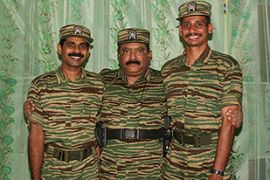Tamil Tiger aircraft target Colombo
LTTE says deadly attack on Sri Lanka’s capital was a suicide mission.

The Associated Press news agency reported, quoting Dr Hector Weerasinghe of Colombo National Hospital, that the raid killed two people and injured 51 others.
Both the pilots were also killed.
Kamikaze-style attacks
The LTTE said on the Tamilnet website that two of its pilots, from its elite Black Air Tiger squad, were sent on kamikaze-style attacks.
The website published a photograph of the men with Velupillai Prabhakaran, the LTTE leader.
| In video |
|
|
The LTTE has a small fleet of aircraft that it has previously used to carry out aerial attacks on Colombo.
Keheliya Rambukwella, the Sri Lankan defence spokesman, said that the military has so far destroyed or taken over six LTTE airstrips in the northeast, but that there could be a seventh one allowing the group to launch Friday’s raid.
However, he insisted that the LTTE would be defeated, saying: “Right now we are very confident that this will come to an end.”
Al Jazeera’s David Hawkins, reporting from Colombo, said the attack brought that claim into question.
“[It] raises the question about whether the Tamil Tigers really are surrounded in [a]small patch of territory and whether or not it will be, in fact, a matter of weeks before the government forces manage to eradicated the Tamil Tigers,” he said.
Camp for displaced
The government claims it has encircled the LTTE in under 100sq km of jungle in the north, but the attack shows that the separatists have the ability to strike far from the conflict zone.
The LTTE has been fighting for a separate homeland for ethnic Tamils in the northeast of the country since the early 1980s. Thousands have been killed in the conflict to date.
The ongoing military offensive has trapped a large number of Tamil civilians in the north, with around 30,000 of them ending up in government shelters for displaced people.
| Focus: Sri Lanka | ||||||

|
Al Jazeera was given access by the Sri Lankan government to one such camp in Vavuniya district, where officials said about 2,700 people are being provided food, clean water and access to medical care.
Colombo says its “welfare villages” meet international standards, and the government intends to build at least three other permanent camps in the Vavuniya and Mannar regions.
However, rights groups argue the camps are detention centres, because the refugees have not been allowed to leave.
Human Rights Watch said that living conditions in the facilities are little better than prisons.
Rajiva Wijesinha, Sri Lanka’s disaster management and human rights minister, rejected those claims.
“Human Rights Watch is a bunch of liars … I think what you’d better look at is the UN reports of people going in,” he told Al Jazeera by phone.
“I think the standard that we are operating on has actually been mentioned by the UN as being slightly better than what is the minimum standard.”

